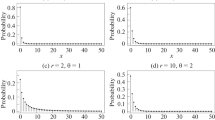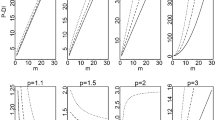Abstract
It has been argued that by truncating the sample space of the negative binomial and of the inverse Gaussian-Poisson mixture models at zero, one is allowed to extend the parameter space of the model. Here that is proved to be the case for the more general three parameter Tweedie-Poisson mixture model. It is also proved that the distributions in the extended part of the parameter space are not the zero truncation of mixed Poisson distributions and that, other than under the negative binomial, they are not mixtures of zero truncated Poisson distributions either. By extending the parameter space one can improve the fit when the frequency of one is larger and the right tail is heavier than is allowed by the unextended model. Extending the model also allows one to use the maximum likelihood based inference tools when the m.l.e. does not exist under the unextended model. The extended model is proved useful in the analysis of frequency count data.
Similar content being viewed by others
References
Aalen OO (1992) Modelling heterogeneity in survival analysis by the compound Poisson distribution. Ann Appl Probab 4:951–972
Baayen H (2001) Word frequency distributions. Kluwer, Dordretch
Bar-Lev SK, Enis P (1986) Reproducibility and natural exponential families with power variance functions. Ann Stat 4:1507–1522
Böhning D, Kuhnert R (2006) Equivalence of truncated count mixture distributions and mixtures of truncated count distributions. Biometrics 62:1207–1215
Dunn PK, Smyth GK (2008) Evaluation of Tweedie exponential dispersion model densities by Fourier inversion. Stat Comput 18:73–86
El-Shaarawi AH, Zhu R, Joe H (2010) Modelling species abundance using the Poisson-Tweedie family. Environmetrics. doi:10.1002/env.1036
Engen S (1974) On species frequency models. Biometrika 61:263–270
Engen S (1978) Stochastic abundance models: with emphasis on biological communities and species diversity. Chapman Hall, London
Fisher RJ, Corbet AS, Williams CB (1943) The relation between the number of species and the number of individuals in a random sample from an animal population. J Anim Ecol 12:42–58
Gerber HU (1991) From the generalized gamma to the generalized negative binomial distribution. Insurance: Math Econ 10:303–309
Ginebra J, Puig X (2010) On the measure and the estimation of evenness and diversity. Comput Stat Data Anal 54:2187–2201
Good IJ (1953) The population frequencies of species and the estimation of population parameters. Biometrika 40:237–264
Griffiths DA (1973) Maximum likelihood estimation for the beta-binomial distribuiton and an application to the household distribution of the total of cases of a disease. Biometrics 29:637–648
Holmes DI (1992) A stylometric analysis of mormon scripture and related texts. J R Stat Soc Ser A 155:91–120
Hougaard P (1986a) Survival models for heterogeneous populations derived from stable distributions. Biometrika 73:387–396
Hougaard P (1986b) A class of multivariate failure time distributions. Biometrika 73:671–678
Hougaard P (1987) Modelling multivariate survival. Scand J Statist 14:291–304
Hougaard P, Lee M-LT, Whitmore GA (1997) Analysis of overdispersed count data by mixtures of Poisson variables and Poisson processes. Biomerics 53:1225–1238
Janzen DH (1973) Sweep samples of tropical foliage insects: description of study sites, with data on species abundances and size distributions. Ecology 54:659–686
Johnson NL, Kemp AW, Kotz S (2005) Univariate discrete distributions, 3rd edn. Wiley, New York
Jorgensen B (1987) Exponential dispersion models. J R Stat Soc Ser B 49:127–162
Jorgensen B (1997) The theory of dispersion models. Chapman Hall, London
Katti SK, Gurland J (1961) The Poisson Pascal distribution. Biometrics 17:527–538
Kokonendji CC, Dossou-Gbete S, Demétrio CGB (2004) Some discrete exponential dispersion models: Poisson-Tweedie and Hinde-Demetrio classes. SORT 28:201–214
Ord JK, Whitmore G (1986) The Poisson-inverse Gaussian distribution as a model for species abundance. Commun Stat Theory Methods 15:853–871
Panjer H (1981) Recursive evaluation of a family of compound distributions. ASTIN Bull 12:22–26
Puig P, Valero J (2006) Count data distributions: Some characterizations with applications. J Am Stat Assoc 101:332–340
Puig X, Ginebra J, Pérez-Casany M (2009) Extended truncated inverse Gaussian-Poisson model. Stat Model 9:151–171
Puig X, Ginebra J, Font M (2010) The Sichel model and the mixing and truncation order. J Appl Stat 37:1585–1603
Puri PS, Goldie CM (1979) Poisson mixtures and quasi-infinite divisibility of distributions. J App Prob 16:138–153
Riba A, Ginebra J (2006) Diversity of vocabulary and homogeneity of literary style. J Appl Stat 33:729–741
Sichel HS (1975) On a distribution law for words frequencies. J Am Stat Assoc 70:542–547
Sichel HS (1997) Modelling species-abundance frequencies and species-individual functions with the generalized inverse Gaussian-Poisson distribution. S Afr Stat J 31:13–37
Tweedie MCK (1984) An index which distinguishes between some important exponential families. In: Ghosh JK, Roy J (eds) Statistics: applications and new directions, proceedings of the Indian Statistical Institute Golden Jubilee International Conference, pp 579–604. Indian Statistical Institute, Calcutta
Valero J, Pérez-Casany M, Ginebra J (2010a) On zero truncating and mixing Poisson distributions. Adv Appl Probab 42:1013–1027
Valero J, Ginebra J, Pérez-Casany M (2010b) Extended truncated Tweedie-Poisson model. Technical Report # 965, Centre de Recerca Matemàtica, Universitat Autonoma de Barcelona
Willmot GE (1988) A remark on the Poisson-Pascal and some other contagious distributions. Stat Prob lett 7:217–220
Zhu R, Joe H (2009) Modelling heavy-tailed count data using a generalized Poisson-inverse Gaussian family. Stat Prob lett 70:1695–1703
Author information
Authors and Affiliations
Corresponding author
Rights and permissions
About this article
Cite this article
Valero, J., Ginebra, J. & Pérez-Casany, M. Extended Truncated Tweedie-Poisson Model. Methodol Comput Appl Probab 14, 811–829 (2012). https://doi.org/10.1007/s11009-012-9277-8
Received:
Revised:
Accepted:
Published:
Issue Date:
DOI: https://doi.org/10.1007/s11009-012-9277-8
Keywords
- Extended truncated negative binomial
- Overdispersion
- Poisson mixture
- Species frequency
- Truncated distribution
- Tweedie models
- Words frequency




